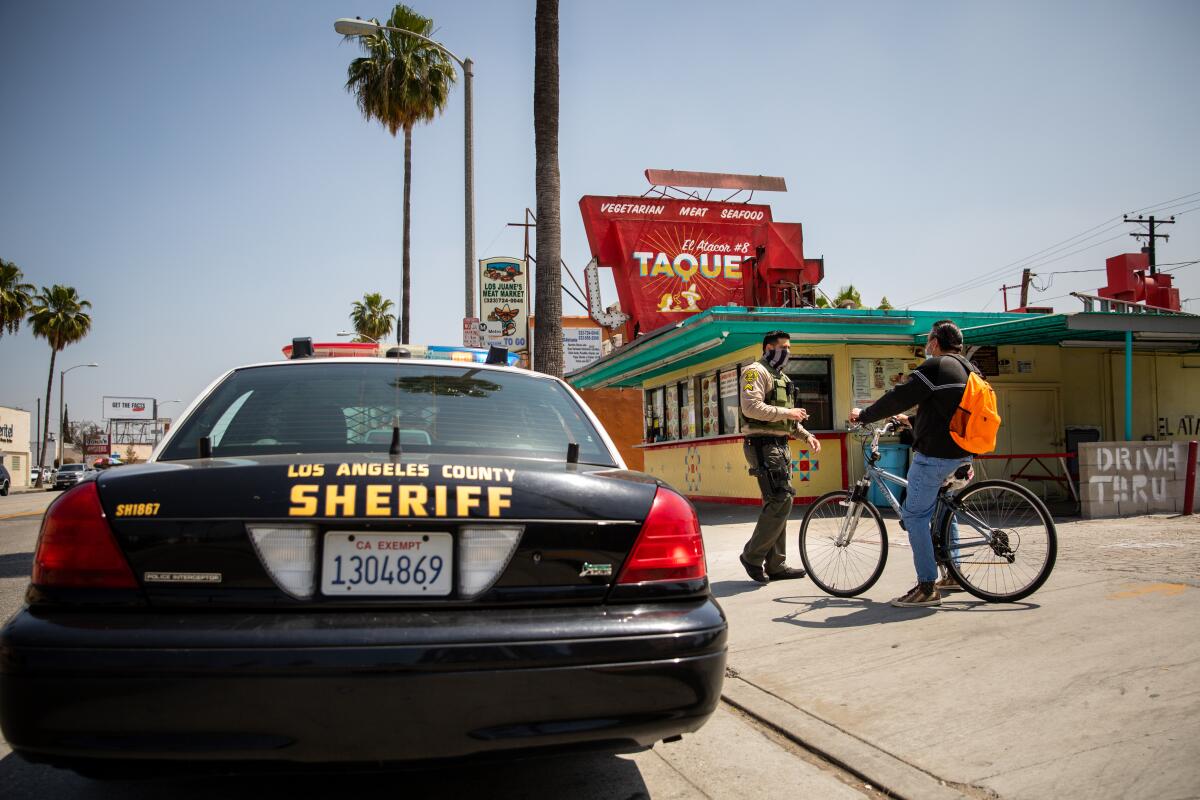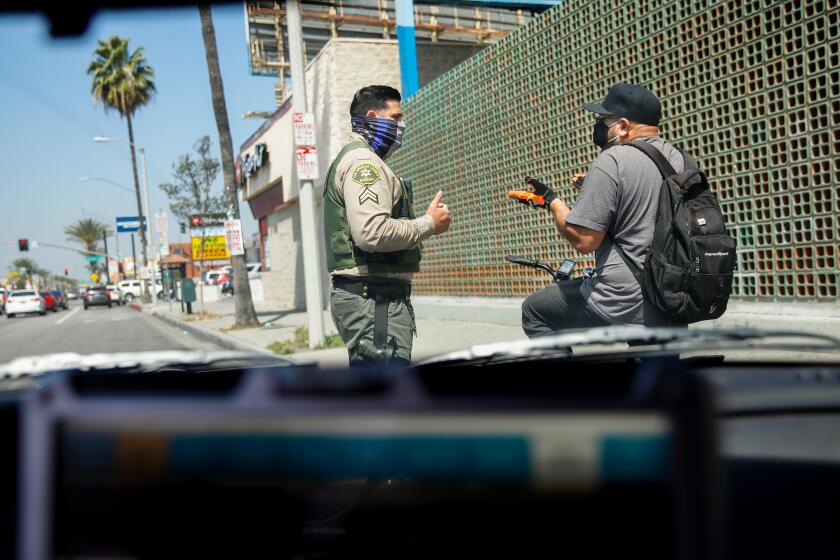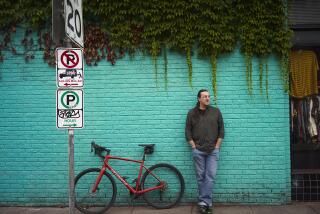Why do L.A. sheriff’s deputies stop and search so many bicyclists? Insiders cite culture and training

- Share via
For years, Los Angeles County sheriff’s deputies have used an aggressive strategy on people riding bicycles: Stop them for minor violations and then search them for drugs or guns.
It has resulted in tens of thousands of cyclists being pulled over and searched in recent years, even when deputies have no reason to suspect serious wrongdoing. A Times investigation last month found it is not an effective policing tool: Fewer than 1 of every 10 cyclists searched were found carrying something illegal, and deputies very rarely discovered weapons. The analysis also found that Latino bicyclists are stopped more frequently than others.
After The Times’ investigation, the L.A. County Board of Supervisors ordered a review of the Sheriff’s Department’s bike stop practices, and the county’s inspector general launched an audit.
The Times’ findings lead to a question: Why do deputies persist in stopping and searching so many bike riders?
Former and current sheriff’s officials said the answer is rooted in a department culture that prioritizes making arrests.
“Everybody likes a good bust,” said J.P. Harris, a retired sheriff’s lieutenant who sits on the Sheriff Civilian Oversight Commission. “The person out there making the good hooks, they’re respected, they’re looked up to.”
And bike riders, sources said, are easy targets for a deputy on patrol, who can legally make a stop if a cyclist is violating any one of many small infractions, such as riding without a reflector or riding on the sidewalk in many parts of the county.
“Like a lion hunting for prey, what is she going to do? Look for the weakest link. That’s what cops do — they look for the easiest stop,” said a sheriff’s source, who, like other current officials, asked to remain anonymous because he is not authorized to speak publicly.
One sheriff’s sergeant said that as a new deputy, a training officer in Compton told him he should assume that in neighborhoods with high crime rates, any adult riding a bicycle had probably lost their license because of a crime they committed.
“That’s the training mentality behind it, why do we do bike stops,” the sergeant said. “They’ve already been guilty of something.”
He said stopping cyclists in order to issue them tickets is not the goal.
The Times filed a public records request for information about bike stops that Los Angeles County sheriff’s deputies made from 2017 through the end of July.
“We don’t stop for that. We say we stop for that because that’s the probable cause to stop,” the sergeant said, referring to the legal justification for a stop. “But we’re not looking for tickets, we’re looking for guns and drugs.”
He added: “The more stops you make, the more guns and drugs you find.”
The sheriff’s own statistics raise questions about whether that practice is worthwhile. The Times investigation found that deputies searched 85% of the more than 44,000 cyclists they pulled over from 2017 through July of this year, but uncovered illegal items in only 8% of searches. Weapons were seized 164 times — less than 0.5% of all searches.
“I suspect that the occasional drug or gun find is very reinforcing,” said Jack Glaser, a professor of public policy at UC Berkeley who has studied traffic stop data. “It may be further reinforced when [deputies] get back to the station and they have a gun to show for their efforts. But there doesn’t appear to be much in terms of negative reinforcement for fruitless searches, so that goes unpunished.”
A Sheriff’s Department spokesperson said the agency had not conducted its own analysis of deputies’ bike stops.
Members of a civilian panel that oversees the Los Angeles County Sheriff’s Department called on an independent watchdog to examine stops of bicyclists after a Times investigation found deputies routinely search cyclists and stop Latinos at a high rate.
Reflecting on a 35-year career in policing, which included the so-called war on drugs, when law enforcement aggressively targeted low-level drug users, Harris questioned whether a strategy of using minor violations as a pretense to search people and find small amounts of drugs or nothing at all is a good use of deputies’ time.
“We used to say: ‘There’s no such thing as a bad arrest.’ I’m not so sure that statement was true then, and I know it’s not true now,” Harris said. “Some people go for the quantity game: ‘If I stop enough cars, I’ll probably get something.’ That is probably true, but look at all the damage you did while you were searching for that one good thing. And does that justify all that damage?”
Harris said he couldn’t remember how he was first introduced to bike stops as a deputy.
Chuck Wexler, director of the Police Executive Research Forum, a Washington-based nonprofit that works closely with law enforcement agencies and policymakers, said the Sheriff’s Department’s aggressive approach to bike stops is out of step with modern policing.
“In 2021 we know so much more ... and the means don’t justify the ends,” Wexler said. “We learned that in city after city, if your answer to the crime problem is just stopping everybody that walks in an area, you really risk alienating those people. It’s worse than inefficient. It’s damaging.”
Sheriff’s officials said concern for deputy safety contributes to the high number of searches. Unlike with traffic stops, in which drivers can be told to keep their hands on the steering wheel, officials said a deputy and cyclist are immediately face to face.
“A lot of deputies want to search just for their own safety,” said Sgt. Chad Vanden Berg, who trained patrol deputies and others on searches and seizures. “They want to know this person doesn’t have a weapon on them before they start dealing with them.”
But deputies performed cursory pat-downs of a rider’s clothes for weapons in only 13% of stops, The Times’ analysis shows. The rest of the searches were more extensive.
Lt. Kimberly Mendoza, who oversees the sheriff’s academy training, said deputies consider factors such as lighting, whether they are alone, the person’s clothing and whether the person is a suspect in a crime when making stops and doing searches.
In 1997, a deputy was shot and killed during a bike stop in an incident that still reverberates in the department. Deputy Michael Hoenig stopped a rider in South Gate who was flailing his arms and acting erratic. Before Hoenig could exit his car, the rider pulled out a .45-caliber pistol and opened fire through a window.
Although such incidents are exceedingly rare, Hoenig’s death is cited in training materials as a reason for why bike stops pose a unique threat to police. During a patrol shift one evening in April, with Times reporters in the car, Deputy Russell Smith Goudy recalled the date and circumstances of Hoenig’s death.
“So we’re very, very, very cognizant when it comes to conducting bike stops,” said Goudy, who was assigned to a crime suppression unit at the sheriff’s Century station. “Bike stops are very dangerous.”
Sheriff Alex Villanueva suggested the 8% of searches in which contraband is discovered justify the practice. The Times found that less than half a percent of searches uncovered a weapon.
“We’re delivering the message that you’re not free to go pillage through our neighborhoods,” Villanueva said when asked about bike stops at a news conference last week . “If we decide that we’re not going to touch anybody on a bike, well, you get people — you saw the crime rate, the homicide rate 44% (increase) — you have any idea how those people go and kill people? Does it happen magically? No, there’s bad guys, gangsters, on bikes, in cars, armed to the teeth, out looking for a target. They’re going to rob them or they’re going to shoot them.”
Villanueva added: “The people that do that unfortunately are overwhelmingly Latinos, African Americans, that is a demographic of that group. The fact that we are actually focusing on them does not mean we’re disproportionately or have any racist motive to address that. It’s the grim reality of it.”
The Times found 7 of every 10 bike stops involve Latino cyclists, a rate significantly higher than Latinos’ share of the county population and their estimated share of bicyclists. The analysis also found that bike riders in poorer communities with large nonwhite populations are stopped and searched far more often than those in more affluent, whiter parts of the county.
Retired Sheriff’s Cmdr. Rod Kusch said arrests for low-level crimes that are typical in bike stops can take a deputy away from patrolling the streets for hours while they book the suspect in jail or write a report.
“If they’re disproportionate, meaning you got these huge numbers of bicycle stops and low yield, meaning, low guns or low big crimes ... you’re not getting the value for those stops,” he said.
But, Kusch said, barring deputies from making bike stops altogether would take away a potentially valuable crime-fighting tool. Proactive policing by being visible and focusing attention in areas where crimes are occurring can act as a deterrent, he and others said.
“That was a philosophy that I really employed on a regular basis — constant, conspicuous, uniformed patrol, and interjecting myself wherever I could at any moment to try to prevent something from occurring,” Kusch said.
More to Read
Sign up for Essential California
The most important California stories and recommendations in your inbox every morning.
You may occasionally receive promotional content from the Los Angeles Times.















